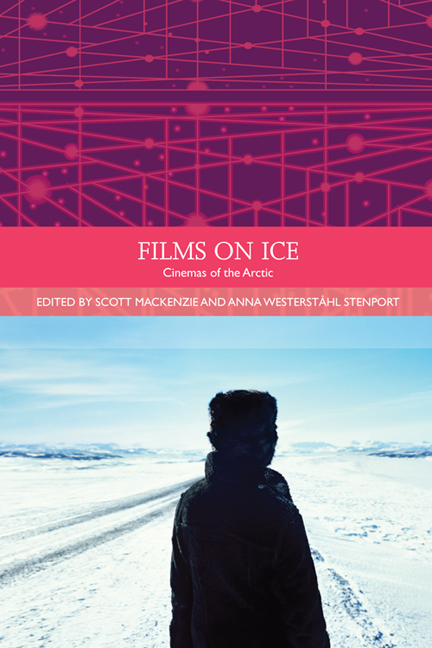Book contents
- Frontmatter
- Contents
- List of Illustrations
- Acknowledgements
- Traditions in World Cinema
- Introduction: What are Arctic Cinemas?
- PART I GLOBAL INDIGENEITY
- PART II HOLLYWOOD HEGEMONY
- PART III ETHNOGRAPHY AND THE DOCUMENTARY DILEMMA
- 14 The Creative Treatment of Alterity: Nanook as the North
- 15 From Objects to Actors: Knud Rasmussen's Ethnographic Feature Film The Wedding of Palo
- 16 Arctic Travelogues: Conquering the Soviet North
- 17 A Gentle Gaze on the Colony: Jette Bang's Documentary Filming in Greenland 1938–9
- 18 Exercise Musk-Ox: The Challenges of Filming a Military Expedition in Canada's Arctic
- 19 The Tour: A Film About Longyearbyen, Svalbard. An Interview with Eva la Cour
- PART IV MYTHS AND MODES OF EXPLORATION
- Notes on the Contributors
- Index
17 - A Gentle Gaze on the Colony: Jette Bang's Documentary Filming in Greenland 1938–9
from PART III - ETHNOGRAPHY AND THE DOCUMENTARY DILEMMA
Published online by Cambridge University Press: 05 September 2016
- Frontmatter
- Contents
- List of Illustrations
- Acknowledgements
- Traditions in World Cinema
- Introduction: What are Arctic Cinemas?
- PART I GLOBAL INDIGENEITY
- PART II HOLLYWOOD HEGEMONY
- PART III ETHNOGRAPHY AND THE DOCUMENTARY DILEMMA
- 14 The Creative Treatment of Alterity: Nanook as the North
- 15 From Objects to Actors: Knud Rasmussen's Ethnographic Feature Film The Wedding of Palo
- 16 Arctic Travelogues: Conquering the Soviet North
- 17 A Gentle Gaze on the Colony: Jette Bang's Documentary Filming in Greenland 1938–9
- 18 Exercise Musk-Ox: The Challenges of Filming a Military Expedition in Canada's Arctic
- 19 The Tour: A Film About Longyearbyen, Svalbard. An Interview with Eva la Cour
- PART IV MYTHS AND MODES OF EXPLORATION
- Notes on the Contributors
- Index
Summary
Among a memorable series of Arctic explorers, scientists and adventurers during the past centuries, few women stand out. One exception is Jette Bang (1914–64), who produced photographic and filmic documentation of Greenland from 1937 onwards. Her extraordinary number of high-quality photographs, now available in a vast digital archive, had a profound influence upon Danish and Greenlandic perceptions of life in Greenland during and after World War II. Her early films, in contrast, were widely neglected and have only recently been made available. In particular the film material she recorded in 1938–9 in West Greenland demands further attention. Recorded on the cusp of World War II, which effectively cut off Greenland from Denmark for a half decade, the films function both as early ethnographic representations of people on the West Coast of Greenland and as valuable documents about Danish colonisation of the island.
Bang was only twenty-two years old when, in 1936, she set out on the first of several extended stays in Greenland, returning in 1938–9, 1945, 1956–8 and 1961–2. With her cameras she documented, as no one else did, Inuit life during decades of major societal change – from decentralised and mainly hunter-gatherer based ways of living to increased ‘modernisation’, industrialisation and urban life. She was extremely productive with both her photo and film cameras. Moreover, she was remarkable for combining an aesthetic sense of framing, an ethnographic curiosity and a human sensibility which made men and women of all ages allow her and her cameras into virtually every sphere of life. Trained in photography and backed by Copenhagen's trend-setting avant-garde photo gallery Jonals and Co. (Meyer 2000), which put at her service the newest stateof- the-art equipment available in the world, the young and determined Bang produced an extraordinary body of photographic and filmic work.
When Bang returned from her first journey to Greenland in 1936, she arranged a large exhibition at the Kunstindustrimuseet (Danish Design Museum) in Copenhagen – one of the first major exhibitions to present Greenland to a broader Danish public. She also published around 190 of her photographs in a photobook, Grønland (‘Greenland’, 1940), and allowed others (for example, Birket-Smith 1961) to distribute some of her 4,000–plus photographs from the journey.
- Type
- Chapter
- Information
- Films on IceCinemas of the Arctic, pp. 235 - 244Publisher: Edinburgh University PressPrint publication year: 2014

